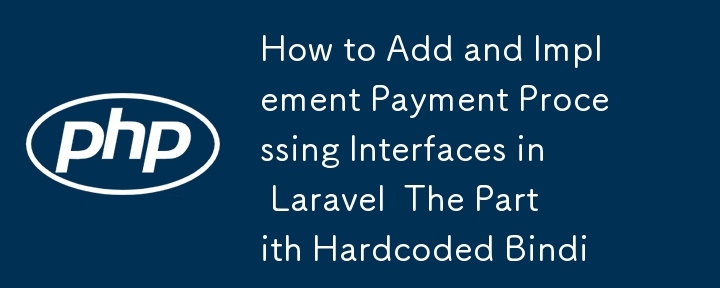

In this blog post, we’ll explore how to take the first step in adding and implementing a payment processing interface in a Laravel 11 application. We'll start by creating a hardcoded binding between the PaymentProcessorInterface and a specific implementation, such as StripePaymentProcessor. This approach is a foundational setup, laying the groundwork for more advanced techniques like dynamic binding and using factories, which we’ll cover in future posts.
Laravel encourages a clean and organized codebase. When implementing interfaces, we’ll typically place them inside the AppContracts directory.
If the Contracts directory doesn't exist yet in our application, we can create it by running the following command in the terminal:
mkdir app/Contracts
This directory will serve as the location for all our application interfaces, keeping them separate from the concrete implementations.
Now that we have the Contracts directory, let’s create a new file where the PaymentProcessorInterface will live. To do so, run the following command:
touch app/Contracts/PaymentProcessorInterface.php
This will create an empty file that we will populate in the next step.
In our newly created PaymentProcessorInterface.php file, define the interface as follows:
<?php
namespace App\Contracts;
interface PaymentProcessorInterface
{
public function createPayment(float $amount, string $currency, array $paymentDetails): array;
public function processPayment(array $paymentData): array;
public function refundPayment(string $transactionId, float $amount): bool;
}
This interface will act as a contract, ensuring that any class implementing it will contain the necessary methods for creating, processing, and refunding payments.
With the PaymentProcessorInterface defined, the next step is to create a class that implements this interface. Typically, we would place this implementation in the app/Services directory.
For instance, let’s create a StripePaymentProcessor class that implements this interface. We can create the file by running:
touch app/Services/StripePaymentProcessor.php
Then, implement the class as shown below:
<?php
namespace App\Services;
use App\Contracts\PaymentProcessorInterface;
class StripePaymentProcessor implements PaymentProcessorInterface
{
public function createPayment(float $amount, string $currency, array $paymentDetails): array
{
// Stripe-specific payment creation logic
}
public function processPayment(array $paymentData): array
{
// Stripe-specific payment processing logic
}
public function refundPayment(string $transactionId, float $amount): bool
{
// Stripe-specific payment refund logic
}
}
This class now contains the necessary methods to create, process, and refund payments via Stripe’s API. We can replace or extend this with other payment processors as needed by creating additional classes implementing the same interface.
Now that the interface and its implementation are ready, we need to tell Laravel how to resolve the PaymentProcessorInterface. In this first step, we’ll use a hardcoded binding by explicitly binding the interface to a specific implementation in Laravel’s service container.
To do this, we can modify the AppServiceProvider or create a new service provider.
In app/Providers/AppServiceProvider.php, add the following code inside the register method:
public function register()
{
$this->app->bind(
\App\Contracts\PaymentProcessorInterface::class,
\App\Services\StripePaymentProcessor::class
);
}
This binding tells Laravel that whenever the PaymentProcessorInterface is required, it should automatically inject the StripePaymentProcessor class. While this approach works, it is limited because it binds a specific implementation to the interface.
This hardcoded binding is an excellent starting point, but it doesn’t provide the flexibility required for larger applications or when supporting multiple payment processors. In the next part of this series, we’ll explore how to achieve dynamic binding using Laravel’s service container and factories, allowing the system to select different implementations at runtime based on the payment gateway needed:
The above is the detailed content of How to Add and Implement Payment Processing Interfaces in Laravel The Part ith Hardcoded Binding. For more information, please follow other related articles on the PHP Chinese website!
 what is python programming
what is python programming
 How to solve the problem that the phpstudy port is occupied
How to solve the problem that the phpstudy port is occupied
 cdn server security protection measures
cdn server security protection measures
 What is the difference between legacy and uefi?
What is the difference between legacy and uefi?
 How to trade virtual currency
How to trade virtual currency
 What is the function of Huawei nfc?
What is the function of Huawei nfc?
 Introduction to the difference between javascript and java
Introduction to the difference between javascript and java
 Why can't win11 be installed?
Why can't win11 be installed?




